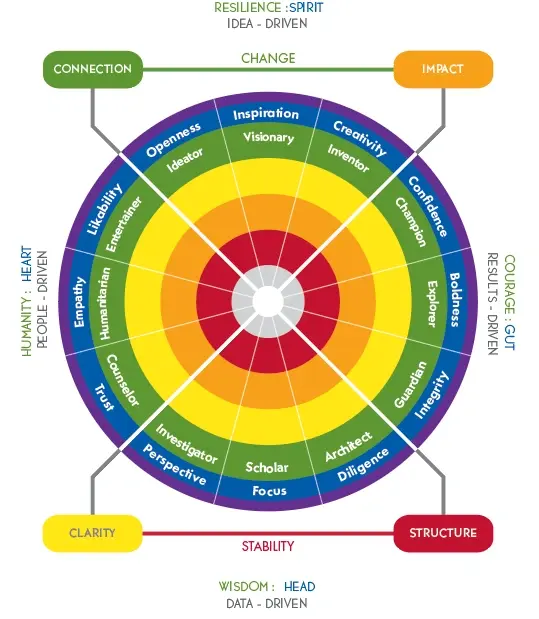How a Hidden Personality Trait Derailed My Job Interview - Part 2

Part 2: Finding Balance
In Part 1, we discussed what happens when you lose your balance and lean too hard in one direction: You may recall that my presentation fell flat because it lacked structure. I had leaned too hard into my desire to be spontaneous and make connections while ignoring the need for structure. So where was the balance I was looking for, and how might I have created an awareness that could have saved me from this humiliating and disappointing experience?
Let's take a look at the tilt model above. Here you can see Connection in the upper left. Directly across from Connection, you see Structure. So by leaning into Connection, I'm actually leaning away from Structure. The further I lean toward Connection, the further I lean away from Structure.
To find balance, I needed less Connection and more Structure. I relied on my strength, Connection, to get me out of trouble but at a certain point, when things became stressful, I leaned too far and lost my balance. When that happened, my strength stopped being a strength. My presentation needed Structure, and by leaning further into Connection, I was doing the opposite of what was needed. What happens when you lean too far? You lose your balance, just like I did.
Too much of a good thing is not always a good thing.
My story was focused on Connection but it just as easily could have been any one of the quadrants shown above. Impact missing Clarity, Structure missing Connection or Clarity missing Impact. Whenever you fall on the model, the key is balance. To find balance, you must begin with awareness. What are your natural proclivities? What do you lean into, and what do you tend to avoid? Often times we avoid what the opposite of our natural, unconscious personality pattern is.
Understanding these things will provide you with a good starting point. One of the best ways to find your starting point is by taking a personality assessment to help you understand your often unconscious preferences. An assessment can provide you with an idea of what you naturally lean into and what things you tend to avoid as they might be uncomfortable or even painful for you. Understanding your tendencies, your strengths, and your struggles will begin to provide you with awareness. Awareness keeps you from having to guess your natural strengths and avoidances. Without awareness, you will most likely wind up following old patterns that cause you to lose your balance and repeat your old stories again and again.
Balance is a two-way street. It’s not just about what you are projecting it’s also about how you are perceived. We all perceive the world differently because our past experiences color our current view of the world, and each of us has a unique life story. By recognizing your patterns, you can begin to see the world more objectively. In my story, I missed the cue for Structure and lost my balance. Had I more awareness, I might have recognized I was leaning in the wrong direction and asserted more Structure rather than leaning further away.
Ways to help maintain balance.
- Understand who you are and your natural tendencies. What do you prefer to lean into, and what things do you prefer to avoid?
- Notice what happens when you are stressed. What are your triggers? Do you continue to lean into your strengths even when they have stopped serving you? Try to notice these patterns from an objective point of view. Do not let them carry you away.
- Doing the work can be challenging from an individual perspective. If you are having difficulty recognizing your patterns, taking a personality assessment and working with a coach or a trained professional is a great way to obtain a more objective point of view.
Please join me for part one, if you missed it.




